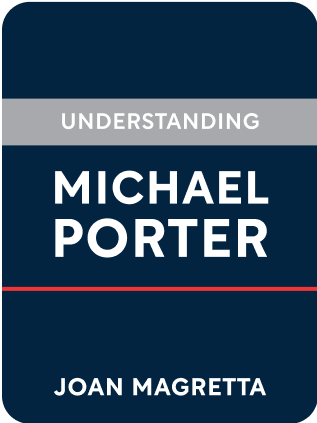

This article is an excerpt from the Shortform summary of "Understanding Michael Porter" by Joan Magretta. Shortform has the world's best summaries of books you should be reading.
Like this article? Sign up for a free trial here .
Scope creep is the tendency for companies to extend their product to do more than it really should. Managing scope creep is vital for building an enduring, successful business strategy. By effectively managing scope creep, you can help your business grow without risking loss of identity or your business plan.
Managing Scope Creep
The temptations to be something for everyone are strong. Willfully ignoring large segments of customers feels like leaving growth on the table. Product designers want their products to do more to get more users. “The customer is always right,” and we want to make all customers happy!
Pressures from financial and management observers are also strong:
- Financial analysts want every company to look like the market favorite.
- Consultants benchmark you against everyone else in the industry, perhaps choosing the wrong metrics for your business (same-store sales, or revenue per employee). If you’re choosing a different positioning, different metrics will be relevant.
- Short-term stock traders put pressure on companies to enact change, while strategy takes years to build.
These itches push companies to straddle their trade-offs, matching the benefits of a different successful position while maintaining its existing position. This can mean designing a product or value chain that services contradictory needs. This leads to inefficiencies, creating openings for focused rivals to deliver superior value or lower prices to customers.
Example: BA started a low-cost airline Go Fly as an independent subsidiary. But Go Fly retained features from BA that were hard to remove, like seat assignments and food service. It sold Go Fly to a private equity firm, which was able to make more of it.
- (Shortform note: this also suggests the difficulty of having a company disrupt itself, especially when the new subsidiary is funded by the parent org. The subsidiary will tend not to be as aggressive as a fully independent competitor that actively seeks to harm its rivals.)
The lesson: deliberately choose not to serve all customers and needs. Otherwise, you risk doing a poor job of serving any customers and needs. Deliberately make some customers unhappy.
Enduring companies have been surprisingly adamant about not compromising their original mission, willfully forsaking short-term growth and defending its key trade-offs against many attacks. Instead of broadening your strategic position, deepen and extend it.
(Shortform note: note that this necessarily suggests inflexibility in company strategy, even in the face of disruption. Applied to Blockbuster in 2000, this approach would suggest, “Your value chain is focused on in-store rentals. Trying to service mail rentals will compromise your advantage.” This can lead to wishful thinking like “people love the experience of walking through stores and holding DVDs. We need to preserve this advantage.” In hindsight, this would be wrong.
From a societal point of view, Porter might say “companies come and go; it’s better for companies that are disrupted to stick to their guns in the case their need endures, rather than straddle and burn capital on a losing strategy.”
So Understanding Michael Porter isn’t as strong in prescribing what to do in the face of rivalry or disruption – it doesn’t guide on how to respond to encroachment from rivals, and how to tell when expanding scope compromises your value chain or not.)
Unique Value Chain
A good strategy delivers distinctive value through a distinctive value chain. It must perform different activities from rivals, or perform similar activities in different ways.
Otherwise, a “unique” value proposition delivered through the same activities will prohibit differentiation/cost advantage, leading to competition to be the best. Also, if the same value chain can deliver the same value proposition, it has no strategic relevance.
Even if the product looks identical, there are many opportunities along the value chain for differentiation – delivery, disposal, support, financing, and more.
When finding a new strategic position, starting with the value proposition is intuitive, but starting with the value chain is equally valid. This is what companies do when they identify their strengths, then figure out how they can apply it to a customer need.
Examples of Unique Value Chains
- How could Progressive make high-risk customers work financially, where others had failed? They further segmented groups to find pockets of lower risk – motorcycle riders over 40 years old; drivers with accident history who have children. They also decreased cost of accidents by having inspectors issue checks on the spot, thus decreasing lawsuits.
- Enterprise leased locations in the city rather than airport rental areas, which were more convenient for their customers and also cheaper. Their target customers were less picky about cars, allowing Enterprise to stock budget, older vehicles. It marketed to insurance companies and car dealerships, rather than expensive consumer ads.
- Low-cost, high-volume Aravind Eye Hospital operationalized eye surgery, optimizing surgeon’s time by prepping the next patient as the operation was ongoing.
- Southwest made a host of changes to support their lower prices. Where traditional airlines serviced every point A to point B through a hub and spoke model, Southwest offered fewer routes but flew direct. They flew from secondary airports that were often more convenient to cities and also lower cost for the airline. Southwest cut out frills like food and higher class seats. They decreased plane turnaround time through a first-come first-serve boarding process, reducing meals, and standardizing their fleet. Finally, where airlines jumped to travel booking sites like Expedia, Southwest adamantly maintained its own website, preventing price comparison.
Exercise: What Not to Do
Look at your value chain, and think about the tradeoffs.
What is your unique value proposition? Which customers are you going to serve? Which of your customers’ needs are you going to meet? What relative price will you offer?
What are the key activities you’re doing to deliver your value proposition?
How do these activities represent trade-offs? For each activity, what are you choosing NOT to do? What does this mean for the ability of competitors to replicate your strategy?
Managing scope creep isn’t easy and requires diligence. With the right business strategy, managing scope creep gets easier and makes your business stronger.

———End of Preview———
Like what you just read? Read the rest of the world's best summary of Joan Magretta's "Understanding Michael Porter" at Shortform .
Here's what you'll find in our full Understanding Michael Porter summary :
- How Porter's famous Five Forces help you analyze every industry
- How IKEA, Southwest Airlines, and Zara have ironclad, defensible strategies
- Why the best companies reject opportunities to focus on what they know






